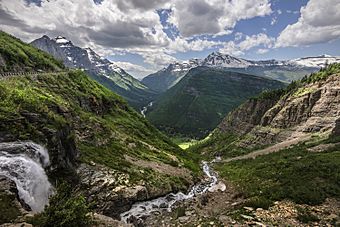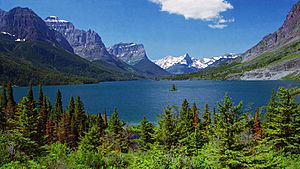Going-to-the-Sun Road facts for kids
|
Going-to-the-Sun Road
|
|

Looking east from Logan Pass toward Going-to-the-Sun Mountain (left foreground)
|
|
| Location | Glacier National Park, Flathead / Glacier counties, Montana, USA |
|---|---|
| Nearest city | West Glacier, Montana |
| Built | 1921-1932; dedicated 1933 |
| Architect | National Park Service; Bureau of Public Roads |
| NRHP reference No. | 83001070 |
Quick facts for kids Significant dates |
|
| Added to NRHP | June 16, 1983 |
| Designated NHL | February 18, 1997 |
The Going-to-the-Sun Road is a beautiful mountain road in the Rocky Mountains. It's located in Glacier National Park in Montana, western United States. People often call it the "Sun Road." It's the only road that goes all the way through the park.
This road crosses the Continental Divide at Logan Pass. This pass is the highest point on the road, sitting at 6,646 feet (2,026 meters) high. Building the road started in 1921 and finished in 1932. It was officially opened on July 15, 1933.
The Going-to-the-Sun Road is very special. It's the first road to be listed as a National Historic Place, a National Historic Landmark, and a Historic Civil Engineering Landmark. The road is about 50 miles (80 km) long. It stretches across the park from the east entrance to the west entrance.
This road is one of the hardest in North America to clear of snow each spring. At Logan Pass, the snow can be as deep as 80 feet (24 meters)! There's a spot just east of the pass called the "Big Drift" where the snow is even deeper. It takes about ten weeks to plow the road. Even with powerful machines that can move 4,000 tons of snow in an hour, crews might only clear 500 feet (150 meters) of road per day.
On the east side of the Continental Divide, you'll see fewer guardrails. This is because heavy snows and avalanches in late winter often destroy them. The road is usually open from early June to mid-October. The latest it ever opened was July 13, 2011.
The Going-to-the-Sun Road has two lanes and is quite narrow and winding. It has many sharp turns, especially west of Logan Pass. Because of this, there are rules for vehicle size. Between Avalanche Creek and Rising Sun picnic areas, vehicles can be no longer than 21 feet (6.4 meters) and no wider than 8 feet (2.4 meters). Also, vehicles taller than 10 feet (3 meters) might not fit under some rock overhangs when driving west from Logan Pass.
Before this road was built, visitors had to spend several days traveling through the middle of the park. Now, you can drive through in just a few hours. This doesn't include time for sightseeing or if there's road construction. The speed limit is 45 miles per hour (72 kph) in flatter areas. It drops to 25 miles per hour (40 kph) in the steeper, winding mountain parts.
Contents
Why is it Called Going-to-the-Sun Road?
The road gets its name from Going-to-the-Sun Mountain. This mountain is a huge sight when you look east from Logan Pass.
There's an old Native American story about the name. It says that a god named Sour Spirit came down from the sun. He taught the Blackfeet people how to hunt. When he went back to the sun, his image was placed on the mountain. It was meant to inspire the Blackfeet. Another story suggests that a European-American explorer named the mountain in the late 1800s. He might have also made up the legend.
How the Road Was Designed
The Going-to-the-Sun Road is special because it was one of the first projects by the National Park Service built for cars. The idea for the road came from superintendent George Goodwin in 1917. He later became the chief engineer for the Park Service. Building the road became his main project, and work began in 1921.
As the project went on, another person, landscape architect Thomas Chalmers Vint, had a different idea for the upper part of the road. He wanted it to follow the Garden Wall cliffs. Vint's plan would mean fewer sharp turns and would make the road blend better with the landscape. It would cost more money, though. When Goodwin left his job, Vint's plan became the chosen one. The entire road finally opened in 1933. It cost about $2.5 million to build.
Road Repairs and Upgrades
The National Park Service and the Federal Highway Administration have been working to repair the road. Over the years, avalanches and rock slides have caused a lot of damage. Repairs started in the 1980s and are still happening today when the weather allows. This work includes fixing retaining walls, replacing the old road surface with stronger concrete, and working on tunnels, bridges, and viewpoints.
Taking a Bus Tour
You can take a guided tour along the road in special red buses. These buses are from the 1930s but were updated in 2001. They are called "Red Jammers" or just "Reds." The original bus drivers were known as "Gear Jammers." This was because they had to "jam" the manual gearbox into a low gear to drive safely on the steepest parts of the road.
Thirty-three of the original buses were rebuilt. They now use special engines that run mostly on propane but can also use gasoline. They also have automatic transmissions, so the "Jammer" name isn't really true anymore! Modern shuttle buses and Blackfeet tour buses also use the road for shorter trips.
Going-to-the-Sun Road in Movies and Music
The Going-to-the-Sun Road appears in the opening of the 1980 movie The Shining. You can see aerial views of Wild Goose Island and the main character's car driving along the north shore of Saint Mary Lake. The car goes through the East Side tunnel on its way to a mountain hotel.
The road is also briefly shown in the 1994 movie Forrest Gump. Forrest talks about running across the U.S. and says, "Like that mountain lake. It was so clear, Jenny. It looked like there were two skies, one on top of the other." The background shots are of Going-to-the-Sun Road and Saint Mary Lake.
The band Fleet Foxes even wrote a song about the road! It's called "Going-to-the-Sun Road" and is on their 2020 album Shore.







